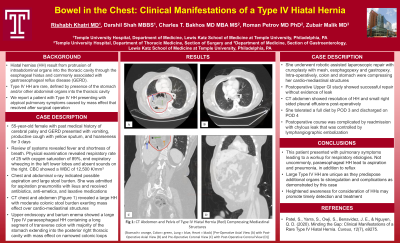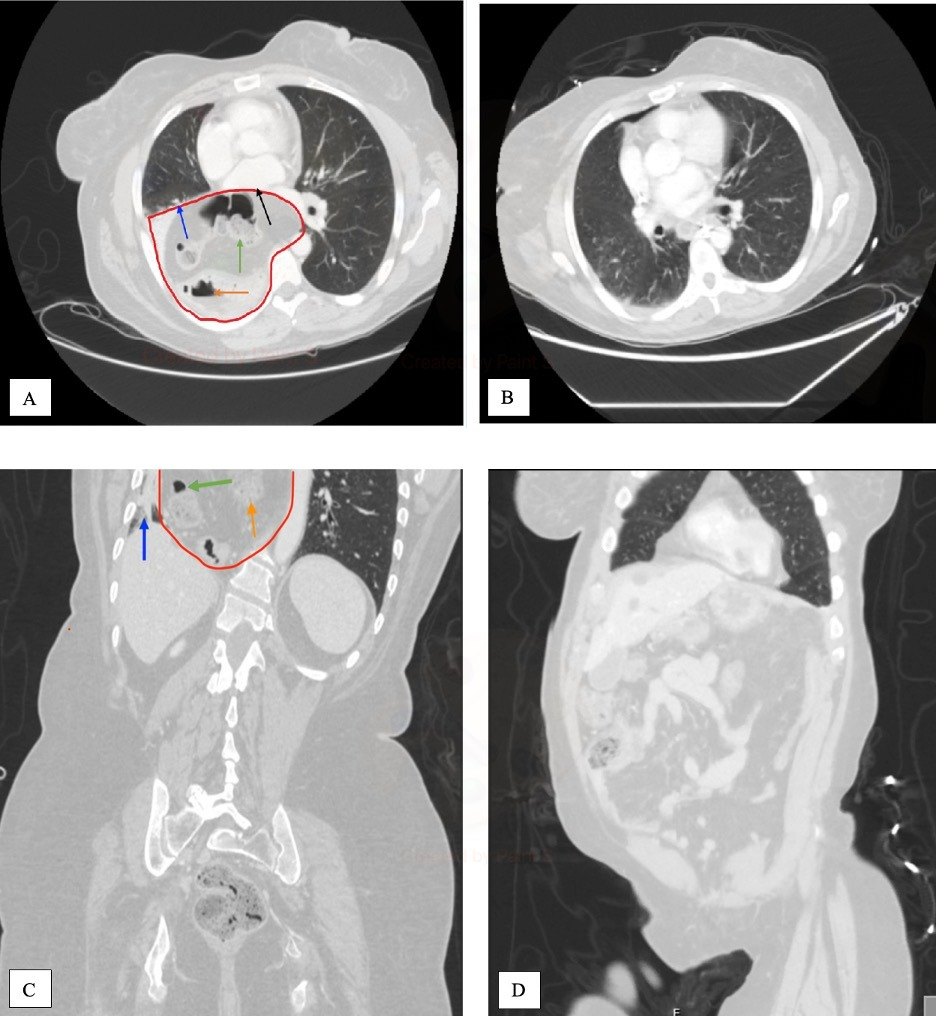Back


Poster Session C - Monday Afternoon
Category: Stomach
C0720 - Bowel in the Chest: Clinical Manifestations of a Type IV Hiatal Hernia
Monday, October 24, 2022
3:00 PM – 5:00 PM ET
Location: Crown Ballroom

Has Audio

Rishabh Khatri, MD
Temple University Hospital
Philadelphia, PA
Presenting Author(s)
Rishabh Khatri, MD, Darshil Shah, MBBS, Charles Bakhos, MD, MBA, MS, Roman Petrov, MD, PhD, Zubair Malik, MD
Temple University Hospital, Philadelphia, PA
Introduction: Hiatal hernias (HH) result from protrusion of intraabdominal organs into the thoracic cavity through the esophageal hiatus and commonly associated with gastroesophageal reflux disease (GERD). Type IV HH are rare, defined by presence of the stomach and/or other abdominal organs into the thoracic cavity. We report a patient with Type IV HH presenting with atypical pulmonary symptoms caused by mass effect that resolved after surgical operation.
Case Description/Methods: 55-year-old female with past medical history of cerebral palsy and GERD presented with vomiting, productive cough with yellow sputum, and hoarseness for 3 days. Review of systems revealed fever and shortness of breath. Physical examination revealed respiratory rate of 25 with oxygen saturation of 89%, end expiratory wheezing in the left lower lobes and absent sounds on the right. CBC showed a WBC of 12,500 K/mm3. Chest and abdominal x-ray indicated possible aspiration and large stool burden. She was admitted for aspiration pneumonitis with ileus and received antibiotics, anti-emetics, and laxative medications. CT chest and abdomen (Figure 1) revealed a large HH with moderate colonic stool burden exerting mass effect over cardio-mediastinal structures. Upper endoscopy and barium enema showed a large Type IV paraesophageal HH containing a long segment of transverse colon with majority of the stomach extending into the posterior right thoracic cavity with mass effect on narrowed colonic loops. She underwent robotic assisted laparoscopic repair with cruroplasty with mesh, esophagopexy and gastropexy. Intra-operatively, colon and stomach were compressing her cardio-mediastinal structures. Postoperative Upper GI study showed successful repair without evidence of leak. CT abdomen showed resolution of HH and small right sided pleural effusions post-operatively. She tolerated a full diet by POD 3 and discharged on POD 4. Postoperative course was complicated by readmission with chylous leak that was controlled by lymphangiographic embolization.
Discussion: This patient presented with pulmonary symptoms leading to a workup for respiratory etiologies. Not uncommonly, paraesophageal HH lead to aspiration and pneumonia, in addition to reflux. Large Type IV HH are unique as they predispose additional organs to strangulation and complications as demonstrated by this case. Heightened awareness for consideration of HHs may promote timely detection and treatment.

Disclosures:
Rishabh Khatri, MD, Darshil Shah, MBBS, Charles Bakhos, MD, MBA, MS, Roman Petrov, MD, PhD, Zubair Malik, MD. C0720 - Bowel in the Chest: Clinical Manifestations of a Type IV Hiatal Hernia, ACG 2022 Annual Scientific Meeting Abstracts. Charlotte, NC: American College of Gastroenterology.
Temple University Hospital, Philadelphia, PA
Introduction: Hiatal hernias (HH) result from protrusion of intraabdominal organs into the thoracic cavity through the esophageal hiatus and commonly associated with gastroesophageal reflux disease (GERD). Type IV HH are rare, defined by presence of the stomach and/or other abdominal organs into the thoracic cavity. We report a patient with Type IV HH presenting with atypical pulmonary symptoms caused by mass effect that resolved after surgical operation.
Case Description/Methods: 55-year-old female with past medical history of cerebral palsy and GERD presented with vomiting, productive cough with yellow sputum, and hoarseness for 3 days. Review of systems revealed fever and shortness of breath. Physical examination revealed respiratory rate of 25 with oxygen saturation of 89%, end expiratory wheezing in the left lower lobes and absent sounds on the right. CBC showed a WBC of 12,500 K/mm3. Chest and abdominal x-ray indicated possible aspiration and large stool burden. She was admitted for aspiration pneumonitis with ileus and received antibiotics, anti-emetics, and laxative medications. CT chest and abdomen (Figure 1) revealed a large HH with moderate colonic stool burden exerting mass effect over cardio-mediastinal structures. Upper endoscopy and barium enema showed a large Type IV paraesophageal HH containing a long segment of transverse colon with majority of the stomach extending into the posterior right thoracic cavity with mass effect on narrowed colonic loops. She underwent robotic assisted laparoscopic repair with cruroplasty with mesh, esophagopexy and gastropexy. Intra-operatively, colon and stomach were compressing her cardio-mediastinal structures. Postoperative Upper GI study showed successful repair without evidence of leak. CT abdomen showed resolution of HH and small right sided pleural effusions post-operatively. She tolerated a full diet by POD 3 and discharged on POD 4. Postoperative course was complicated by readmission with chylous leak that was controlled by lymphangiographic embolization.
Discussion: This patient presented with pulmonary symptoms leading to a workup for respiratory etiologies. Not uncommonly, paraesophageal HH lead to aspiration and pneumonia, in addition to reflux. Large Type IV HH are unique as they predispose additional organs to strangulation and complications as demonstrated by this case. Heightened awareness for consideration of HHs may promote timely detection and treatment.

Figure: Figure 1: CT Abdomen and Pelvis of Type IV Hiatal Hernia (Red) Compressing Mediastinal Structures (Stomach= orange, Colon= green, Lung = blue, Heart = black) [Pre-Operative Axial View (A) with Post-Operative Axial View (B) and Pre-Operative Coronal View (C) with Post-Operative Coronal View (D)]
Disclosures:
Rishabh Khatri indicated no relevant financial relationships.
Darshil Shah indicated no relevant financial relationships.
Charles Bakhos indicated no relevant financial relationships.
Roman Petrov indicated no relevant financial relationships.
Zubair Malik indicated no relevant financial relationships.
Rishabh Khatri, MD, Darshil Shah, MBBS, Charles Bakhos, MD, MBA, MS, Roman Petrov, MD, PhD, Zubair Malik, MD. C0720 - Bowel in the Chest: Clinical Manifestations of a Type IV Hiatal Hernia, ACG 2022 Annual Scientific Meeting Abstracts. Charlotte, NC: American College of Gastroenterology.
